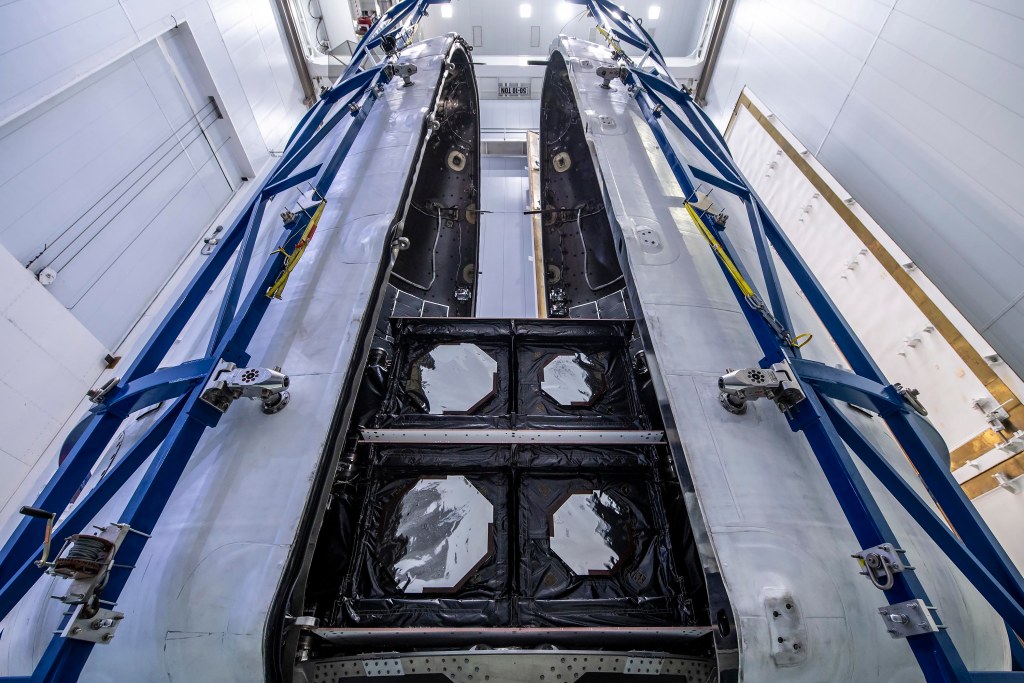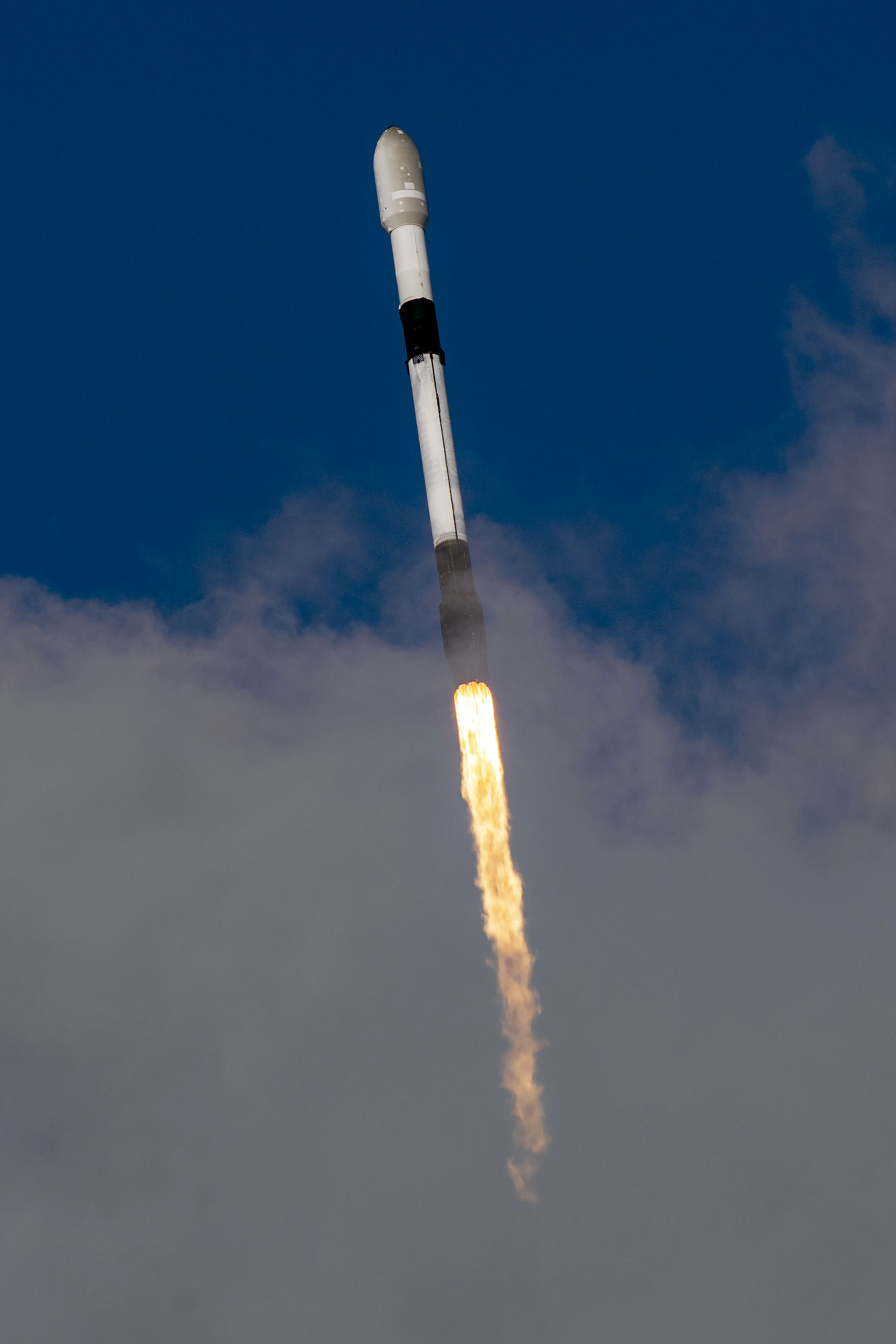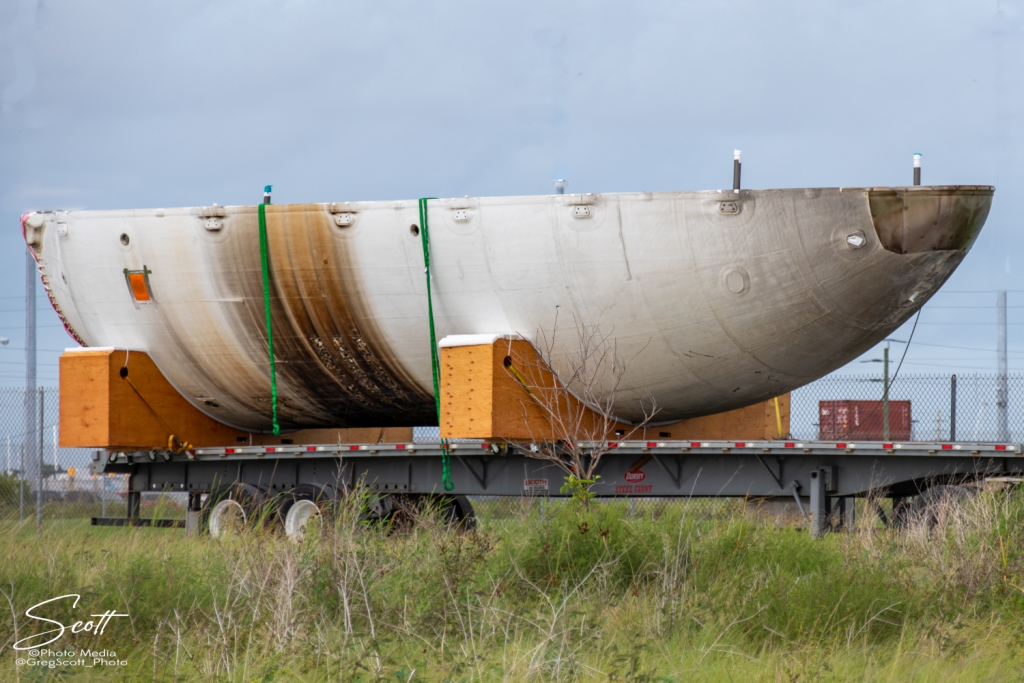Featured Image: SpaceX
Liftoff Time | November 12, 2023 – 21:08 UTC | 16:08 EST |
|---|---|
Mission Name | O3b mPOWER 5 & 6 |
Launch Provider | SpaceX |
Customer | SES S.A. |
Rocket | Falcon 9 Block 5, B1076-9; 38.65-day turnaround |
Launch Location | Space Launch Complex 40 (SLC-40), Cape Canaveral Space Force Station, Florida, USA |
Payload mass | 3,400 kg |
Where did the spacecraft go? | A medium Earth orbit (MEO) at 8,000 km (~5,000 mi) in altitude, and 0 degrees in inclination (equatorial) |
Did they attempt to recover the first stage? | Yes |
Where did the first stage land? | ~685 km downrange on A Shortfall of Gravitas Tug: Crosby Skipper; Support: Bob |
Did they attempt to recover the fairings? | The fairing halves were recovered from the water ~818 km downrange by Bob |
Were these fairings new? | One fairing half flew for the eighth time, and the other one, for the ninth |
This was the: | – 273rd Falcon 9 launch – 205th Falcon 9 flight with a flight-proven booster – 217th re-flight of a booster – 83rd re-flight of a booster in 2023 – 245th booster landing – 51st booster landing on ASOG – 171st consecutive landing (a record) – 84th launch for SpaceX in 2023 – 154th SpaceX launch from SLC-40 – 183rd orbital launch of 2023 |
Where to watch | Official replay |
What’s All This Mean?
SpaceX prepares to launch the O3b mPOWER 5 & 6, two communication satellites of the novel terabit-per-second O3b mPOWER constellation in MEO. The satellites launch atop a Falcon 9 rocket from Space Launch Complex 40 (SLC-40), Cape Canaveral Space Force Station in Florida, USA.

How Did It Go?
Upon completion of the countdown, the Falcon 9 carrying the O3b mPOWER 5 & 6 satellites roared and ascended. Going through all phases of flight nominally, the first stage returned to land onto a SpaceX drone ship awaiting in the ocean. This marked secondary mission success, with the second stage continuing its flight to space. Once all three MVacD burns positioned the stage in the right orbit, the payloads successfully separated, marking primary mission success.
O3b mPOWER 5 & 6 Mission
The O3b mPOWER is a successor of the O3b constellation operating in MEO by SES S.A. It will consist of 11 next-generation high-throughput satellites that will also work in MEO around 8,000 km above the Earth. From MEO, the constellation will cover 96% of the globe. The satellites are built and tested by Boeing and are based on its flight-proven 702 platform. Moreover, the O3b mPOWER 5 & 6 feature an all-electric propulsion system, custom solar arrays manufactured by Spectrolab, and the 702X software-defined payload with more than 5,000 steerable and fully-shapeable beams per satellite.
The O3b mPOWER 5 & 6 satellites make use of a software system called Adaptive Resource Control (ARC). ARC will provide dynamic management of service requests and available resources in orbit and on the ground. SES has been working on ARC with Kythera Space Solutions since September 2019, when they jointly announced the development.

The O3b mPOWER satellite system aims to provide high-performance connectivity services to multiple sectors, including government, energy, and cruise sectors, as well as telecom companies and mobile network operators. Apart from the 11 satellites, the constellation will comprise eight ground stations worldwide and dozens of software service providers. The O3b mPOWER’s start-of-service date is scheduled for Q3 2023 with six satellites in orbit.

Hiccups Before O3b mPOWER 5 & 6
Prior to the announced date for launch in November 2023, these satellites were aiming at launching in June. However, the four already launched members of the constellation had been experiencing a glitch. That is, some of their modules were sporadically losing power. Nevertheless, supply to them could quite easily be restored, never endangering the service they would provide. Luxembourg-based SES, on the side of caution, decided to postpone this launch, the third in the series, to look into it.
After some research, the company informed the satellites for the O3b mPOWER 5 & 6 mission saw improvements in terms of shielding and cabling. In this way, the firm expects to mitigate the occurrence of the malfunction. In spite of the confidence SES expresses on its spacecraft offering service, it would appear the issue still remains a mystery, to an extent. Another possibility implies the full understanding of the problem, but a solution that is too expensive or impractical in another way.
In any case, the first four satellites out of the total 11 will showcase a lower life than previously thought. The coming five should see upgrades, and Boeing will build an extra two of them.
What Is Falcon 9 Block 5?
The Falcon 9 Block 5 is SpaceX’s partially reusable two-stage medium-lift launch vehicle. The vehicle consists of a reusable first stage, an expendable second stage, and, when in payload configuration, a pair of reusable fairing halves.
First Stage
The Falcon 9 first stage contains 9 Merlin 1D+ sea-level engines. Each engine uses an open gas generator cycle and runs on RP-1 and liquid oxygen (LOx). Each engine produces 845 kN of thrust at sea level, with a specific impulse (ISP) of 285 seconds, and 934 kN in a vacuum with an ISP of 313 seconds. Due to the powerful nature of the engine and the large amount of them, the Falcon 9 first stage can lose an engine right off the pad, or up to two later in the flight, and be able to successfully place the payload into orbit.
The Merlin engines are ignited by triethylaluminum and triethylborane (TEA-TEB), which instantly burst into flames when mixed in the presence of oxygen. During static fire and launch the TEA-TEB is provided by the ground service equipment. However, as Falcon 9 first stage is able to propulsively land, three of the Merlin engines (E1, E5, and E9) contain TEA-TEB canisters to relight for the boost back, reentry, and landing burns.
Falcon 9 Booster
The booster supporting the O3b mPower 5 & 6 mission was B1076-9. As the name implies, the booster had flown eight previous times. The booster’s designation changed to B1076-10 upon successful landing.
| B1076’s previous missions | Launch Date (UTC) | Turnaround Time (Days) |
| CRS-26 | November 26, 2022 19:20 | N/A |
| OneWeb 16 | January 10, 2023 04:50 | 44.40 |
| Starlink Group 6-1 | February 27, 2023 23:13 | 48.77 |
| Intelsat 40e/TEMPO | April 7, 2023 04:30 | 38.22 |
| Starlink Group 6-3 | May 19, 2023 06:19 | 42.08 |
| Starlink Group 6-6 | July 24, 2023 00:50 | 65.77 |
| Starlink Group 6-14 | September 9, 2023 03:12 | 47.10 |
| Starlink Group 6-21 | October 5, 2023 05:36 | 26.10 |
Following stage separation, the Falcon 9 conducted two burns. These burns softly touched down the booster on SpaceX’s autonomous spaceport drone ship A Shortfall of Gravitas.
Second Stage
The Falcon 9 second stage is the only expendable part of the Falcon 9. It contains a singular MVacD engine that produces 992 kN of thrust and an ISP of 348 seconds. The second stage is capable of doing several burns, allowing the Falcon 9 to put payloads in several different orbits.
For missions with many burns and/or long coasts between burns, the second stage is able to be equipped with a mission extension package. When the second stage has this package it has a grey strip, which helps keep the RP-1 warm, an increased number of composite-overwrapped pressure vessels (COPVs) for pressurization control, and additional TEA-TEB.

Falcon 9 Fairings
The Falcon 9’s fairing consists of two dissimilar reusable halves. The first half (the half that faces away from the transport erector) is called the active half, and houses the pneumatics for the separation system. The other fairing half is called the passive half. As the name implies, this half plays a purely passive role in the fairing separation process, as it relies on the pneumatics from the active half.
Both fairing halves are equipped with cold gas thrusters and a parafoil which are used to softly touch down the fairing half in the ocean. SpaceX used to attempt to catch the fairing halves; however, at the end of 2020, this program was canceled due to safety risks and a low success rate. On O3b mPOWER 5 & 6, SpaceX successfully recovered the fairing halves from the water with its recovery vessel Bob.
In 2021, SpaceX started flying a new version of the Falcon 9 fairing. The new “upgraded” version has vents only at the top of each fairing half, by the gap between the halves, whereas the old version had vents placed spread equidistantly around the base of the fairing. Moving the vents decreases the chance of water getting into the fairing, making the chance of a successful scoop significantly higher.

O3b mPOWER 5 & 6’s Countdown
All times are approximate
| Hr/Min/Sec | Event |
|---|---|
| 00:38:00 | SpaceX Launch Director verifies go for propellant load |
| 00:35:00 | RP-1 (rocket grade kerosene) loading begins |
| 00:35:00 | 1st stage LOX (liquid oxygen) loading begins |
| 00:16:00 | 2nd stage LOX loading begins |
| 00:07:00 | Falcon 9 begins engine chill prior to launch |
| 00:01:00 | Command flight computer to begin final prelaunch checks |
| 00:01:00 | Propellant tank pressurization to flight pressure begins |
| 00:00:45 | SpaceX Launch Director verifies go for launch |
| 00:00:03 | Engine controller commands engine ignition sequence to start |
| 00:00:00 | Falcon 9 liftoff |
Launch, Landing, and Deployment
All Times are Approximate
| Hr/Min/Sec | Event |
|---|---|
| 00:01:12 | Max Q (moment of peak mechanical stress on the rocket) |
| 00:02:27 | 1st stage main engine cutoff (MECO) |
| 00:02:31 | 1st and 2nd stages separate |
| 00:02:38 | 2nd stage engine starts |
| 00:03:19 | Fairing deployment |
| 00:06:34 | 1st stage entry burn start |
| 00:06:57 | 1st stage entry burn ends |
| 00:07:51 | 2nd stage engine cutoff (SECO-1) |
| 00:08:19 | 1st stage landing burn start |
| 00:08:43 | 1st stage landing |
| 00:26:57 | 2nd stage engine starts (SES-2) |
| 00:27:30 | 2nd stage engine cutoff (SECO-2) |
| 01:56:46 | 2nd stage engine starts (SES-3) |
| 01:57:16 | 2nd stage engine cutoff (SECO-3) |
| 02:00:18 | First O3b mPOWER satellite deploys |
| 02:07:18 | Second O3b mPOWER satellite deploys |
Adapted rocket section’s original author: Trevor Sesnic





This is the milestone flight that should have made SpaceX the launch leader over China Aerospace, SpaceX 267, China Aerospace 264, as it’s unlikely China Aerospace can take the lead again with the high launch cadence that SpaceX and Falcon 9 have achieved this year.